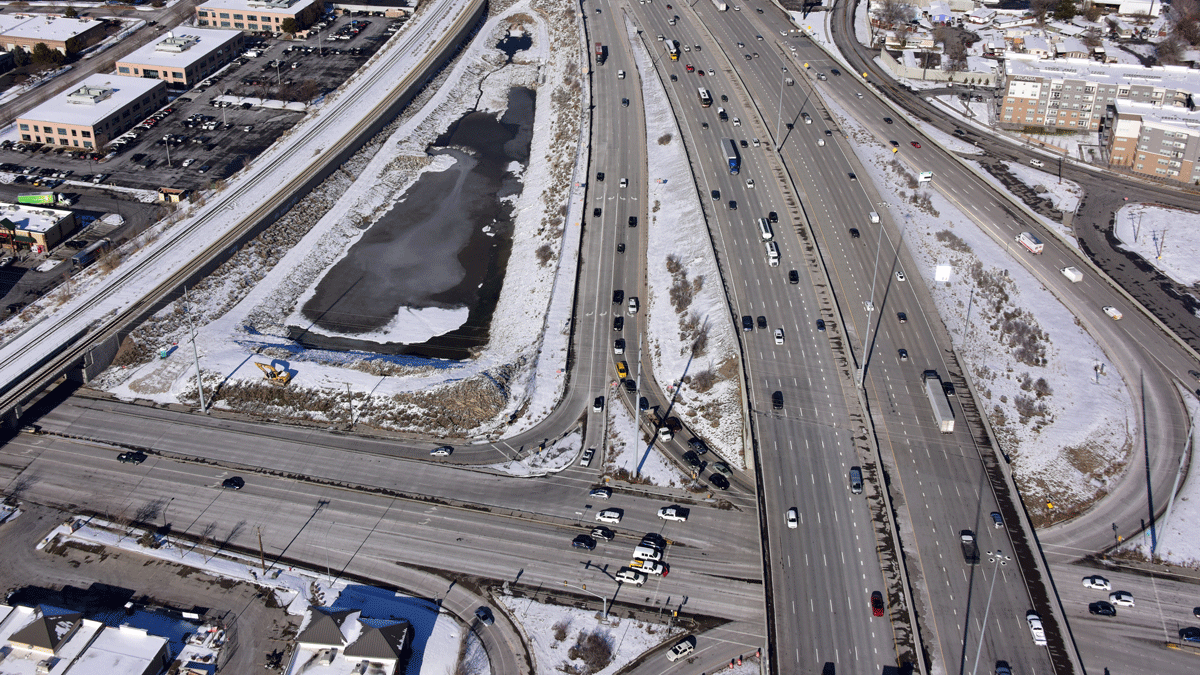With a burgeoning population on track to nearly double over the next 50 years, Utah is facing considerable challenges in keeping up with escalating travel demands on roads and transit systems. Salt Lake County, for example, is projected to add nearly 600,000 new residents by 2065 – roughly one-fifth of the state’s total population growth. During this same time frame the capital county is expected to create 610,000 new jobs, according to researchers at the University of Utah’s Kem C. Gardner Policy Institute.
In anticipation of future economic and population growth, several high-priority infrastructure projects are underway in this region, including the I-15 Southbound Project that began construction last February. This Utah Department of Transportation (UDOT) undertaking is one of several recent South Valley improvement efforts designed to increase roadway capacity and heighten safety for drivers, cyclists and pedestrians.
Ralph L. Wadsworth Construction Company (RLW) is serving as general contractor on the I-15 Southbound Project, which is comprised of three main components:
- Addition of a 12-foot southbound lane to I-15 between SR 201 and 12300 South
- Expansion of 7200 South to three lanes in each direction (from I-15 to Bingham Junction Boulevard in the city of Midvale)
- Modification of the I-15/I-215 interchange to improve traffic movements from eastbound and westbound I-215 to southbound I-15
This $180 million design-build effort will widen approximately 14 miles of roadway and is expected to wrap up by late 2019. Upon completion, traffic flow and congestion will improve considerably – including reducing travel delays between SR 201 and 12300 South by as much as 10 minutes.
“This project will significantly cut down on travel times,” affirms RLW Project Executive Steve McPherson. “We opened up a 6-mile segment of the roadway just prior to Thanksgiving, between 7800 South and 12300 South. We saw an immediate reduction in travel time and travel speeds that were approaching posted speed limits.” Crews are currently continuing work along the northern and southern segments of the project area, including widening a 7-mile segment between 7800 South and SR 201, which is scheduled to open this fall.
Keeping Utah Moving
When it comes to advancing state economics, population growth is advantageous because there are larger numbers of people to energize commerce and sustain labor demands. These surges, however, place a heavy burden on transportation officials to upgrade existing infrastructure rapidly and cost-effectively.
“The improvements on I-15 are really part of a comprehensive long-term plan to keep Utah moving into the future and along the Wasatch Front, a metropolitan area in the north-central part of Utah,” says UDOT Project Director Lisa Zundel, who is overseeing the I-15 Southbound Project.
Around 260,000 motorists traverse the north-south highway each day, leading to heavy traffic congestion during peak travel times.
Zundel adds, “The I-15 Southbound Project will help manage that traffic congestion and allow I-15 to function better with the surrounding transportation system. It is part of a larger comprehensive plan that is being looked at by transportation agencies within the state of Utah. That plan involves looking at land use, transit, technology, connectivity between modes of travel and other things through the year 2050.”
A Modernized Interchange
The existing I-15/I-215 interchange is one major area being revamped on the I-15 Southbound Project. Currently, both east and westbound movements from I-215 go into a collector system before merging with mainline I-15 traffic. This configuration is problematic because bottlenecks often occur when large volumes of traffic from I-215 combine with I-15 traffic at peak traveling periods.
“We decided that splitting the east and westbound volumes of traffic would be the best solution,” Zundel says. The new interchange design calls for westbound I-215 to southbound I-15 movements to merge directly onto mainline I-15, which prevents that traffic from overcrowding the collector system. Motorists traveling from eastbound I-215 to southbound I-15 will still be carried across the collector system, and will merge with a surface street ramp before entering onto mainline I-15.
“The modernized freeway interchange will help to redistribute traffic volumes over a longer length of roadway versus adding all those volumes at one point or one entrance,” McPherson explains. “This provides several advantages as it reduces bottlenecks, enhances safety for commuters and improves travel times.”
The overall project calls for the replacement of two bridges, the narrowing of three bridges, the widening of eight bridges and the preservation of 24 bridges. Three bridges located at this interchange are being narrowed to permit the widening of three bridges situated adjacent to them. Reducing the width of the collector system bridge near 6800 South will be particularly challenging, as a large steel girder weighing approximately 1.2 million pounds spans 700 feet across Union Pacific Railroad (UPRR) and Utah Transit Authority (UTA) rail lines. The structure’s location and size/length, as well as MOT (maintenance of traffic) constraints, had to be considered while devising plans for removal and replacement.
“This spring we will be using two gantry cranes to assist with the removal and replacement of the steel girders,” McPherson says. Manufactured by Mi-Jack Products, the massive 80,000-pound-capacity gantry cranes will be assembled on site and placed on two parallel roadways separated by a gap varying between 9.5 feet and 15 feet. “Each of the gantry cranes will have one track running on the collector-distributor road and one track running on I-15. They’ll span the gap and be able to travel laterally or longitudinally to help with de-erection of the old girders and erection of the new girders.”
Zundel points out that it is not common practice to narrow bridge structures. UDOT and the design-build team had to take extra steps to ensure all the designs worked, including double-checking structural calculations to ensure the bridges would still be structurally sound after the existing girder is removed. “A lot of research and design went into making this narrowing possible. This design choice is a little different than what people would normally see on a roadway construction project, especially when you pair it with the bridge’s unique reconstruction method.”
Project Constraints Require Adaptation
One of the biggest project challenges involved coordinating construction within a very constrained right of way, notes McPherson. “UDOT has an existing right of way that it acquired long ago. On this project, state officials wanted to minimize right-of-way acquisition and try to work within the existing footprint to build the additional lane on I-15,” he says.
While budgetary constraints naturally factored into this decision, UDOT had other reasons for minimizing right-of-way acquisitions.
“We didn’t want to permanently disrupt people’s daily lives in an attempt to buy their homes or businesses. This is something that we try to be very conscientious of as we look at projects. We look for alternatives that are safe for both the contractors and the traveling public,” Zundel notes.
Only a few minor acquisitions were made along the corridor. Ultimately, crews are permitted to work within an area that may leave no more than 1 foot between the right of way and face of the retaining wall supporting I-15. “This essentially pushes the limits of the roadway to the limits of the right of way in many locations,” McPherson explains. “We had to change our constructability approach because we have to build the roadway from behind the location versus in front of it.” To optimize access options and ensure safety for both workers and travelers, project officials had to carefully and thoughtfully stage equipment, tools and resources.
“On this project we also have to abide by several MOT restrictions, which requires us to maintain all lanes of traffic during peak periods. We can only reduce the number of lanes during off-peak periods, which equates to mostly nighttime work. We have also selectively identified areas that can be worked on safely during the daytime without impeding traffic,” McPherson says.
To provide additional flexibility when closing lanes, the project team has temporarily converted the existing HOV lane on I-15 into a general-purpose lane.
McPherson continues, “It’s been a pretty intensive, involved scheduling effort to make sure all the work areas are being addressed within the allotted time frames. The logistics of the project – moving from work area to work area given all the constraints – has been difficult and challenging. But we’ve adapted by implementing different design techniques into our construction approach, ranging from drainage to grading to retaining wall solutions that all fit within the narrow right of way.”
The project is utilizing three different types of mechanically stabilized earth (MSE) retaining wall systems: soil nail, precast post-and-panel, and panel-and-strap.
“In areas with a very tight right of way, there is limited room for things such as utility relocations or excavations, which are normally necessary with traditional MSE wall systems that extend 15-25 feet horizontally from the face of the wall,” McPherson notes. “We developed an alternative design with the post-and-panel wall system that allowed us to increase the retained height with only about 5-10 feet of horizontal impact. This system serves to streamline our approach to the construction process because it can be used in a wider application without disturbing as much roadway, right of way or existing infrastructure as other systems.”
By using this modified system, the construction team limited potential lane closures and lane shifts as well as reduced the narrowing of lane or shoulder widths to accommodate construction activities – all of which maximizes mobility for the traveling public and keeps Utah moving.
https://www.acppubs.com/topics/279-rocky-mountain-construction
Photo courtesy of Richard Green


